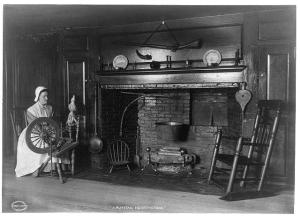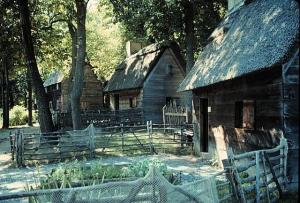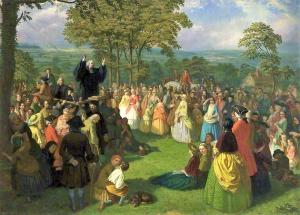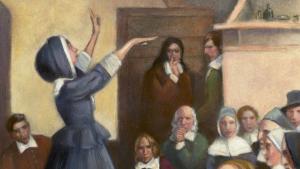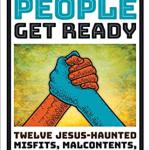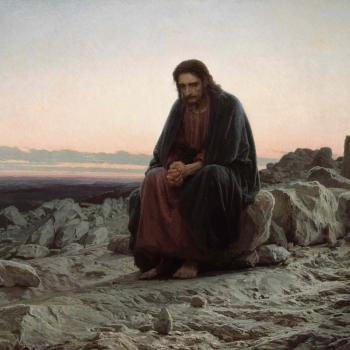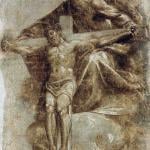The First Peoples (Natives) viewed their geography as a space of spiritual interconnection between ecology and humanity facilitated by the force they called manitou (spirit). Natives approached their geography from the attitude of interdependence rather than dominance. They migrated seasonally to the resources they depended upon: men going on long hunts and women farming and raising children, while maintaining fisheries along the coast or major rivers. To the Natives, geography was not possessed or owned but sacred and shared by all creatures of the Gitchi Manitou (Great Spirit).
Europeans understood geography from a different perspective. The seventeenth century errand into the wilderness by British colonists created new opportunities to expand the British Empire’s global geographic holdings. Colonists came to dominate, possess, and domesticate the land. This is not to say that Puritans viewed the land less sacred than Natives. The project of subduing the geography of the land was a sacred mission. Just as Adam dominated the land and creatures by naming it (Gen. 2), the colonists subdued their geography by naming it New England. In the imagination of Puritans, conquest of New England included a spiritual domestication of the land. The geography of New England must be subdued and put under the sacred domain of Christianity.
Thus, they chartered colonies and villages through companies, which could be mapped and marked on paper. Then they constructed structures upon the land and enclosed them with protective walls by exploiting the geography’s natural resources and commodifying the earth: wood, stone, clay baked bricks. In the eyes of the land’s First Peoples, this process horrified them, for they observed Europeans violating the land and its manitou. Because the untamed wilderness sheltered fairies, spirits (ghosts) and demonic forces—Puritans associated the Natives, who lived interdependently upon their geography, with either pagan or demonic spiritual forces.
As colonists domesticated their newly acquired New England property, they established geographies of power, both physical and spiritual. These geographies of power were gendered. Men and women had authority in different geographical spaces within the community, and they were expected to respect and recognize each other’s authority in those geographies and behave appropriately in those spaces.
Geographies of Power in New England Villages
The geographies of power ultimately rested in the hands of household heads, the men of the community. Husbands and fathers operated as lords and pastors over the home. They had all legal power and covered the rest of the home with their authority. They had all financial power. A household head’s wife could contain all her valuable possessions in a wooden trunk at the foot of her bed.
At the center of a New England village, stood the meeting house, where both civic discussion and sacred worship took place, all under the authority of manly headship. This geographical center of power remained securely in the hands of men. Women sat dutifully and silently in their pews, minding their children’s behavior, while they listened to the minister preach from his pulpit and the magistrate, selectmen, and their husbands stood and spoke on behalf of their families and community in weekly meetings.
On the other hand, other geographies empowered women. Women possessed the most power at the symbolic heart of the home, the hearth. Similar to the heart, which pumps warm blood through the body, the hearth held fire that radiated heat, emanating warmth throughout the home. If the soul of the home turned cold, it was the wife’s, daughter’s, or chamber-maid’s duty to fetch fire from a neighbor or take tinder and rekindle the soul of the home. Every member felt when the soul of the home grew cold, and women took seriously their responsibility to domesticate this space. They painstakingly kept the hearth clear of debris, so fire did not become unwieldily, spread, and destroy the home. As women domesticated the fire in the hearth, they perceived the metaphorical association with their hearts and affections. Their affections empowered them to warm their home and community, as long as they kept them in check, and respected the hierarchy of authority with their gentle, quiet, and sweet dispositions. However, if they let debris come too close to their hearts, their passions might ignite and bring down the whole household upon their heads.
There at the hearth, women dutifully prepared meals that nourished every member and warmed bellies and hearts. They read Scripture and imparted literacy to their children from the light of that fire, and they fashioned or repaired garments, and did other work with their hands, in order to keep from idleness.
The hearth was also a threshold, a gateway to the wilderness outside, and, therefore, a vulnerability. Animals, fairies, familiars, and the spectral spirits of witches might come from the wilderness and invade the home through the chimney threshold. While every household member paid attention to the soul of the home, the hearth, it remained under the special authority and domain of women.
Another geography of power that New England women maintained included the garden immediately surrounding the home. Gardens occupied the space immediately surrounding the home and were enclosed with a gated fence. The fenced enclosure around the garden functioned as an important physical demarcation that the home was domesticated, private property, set apart from the enchanted wilderness without its enclosure. Within this enclosure, the garden contained many good things necessary to nourish the home. Puritan women grew and gathered herbs, fruits, vegetables, and flowers to bring to the cast-iron pot in the hearth of the home. There they made potions of protective and healing magic, which we now call medicine, or they boiled stews, baked pies, and other tasty meals to provide sustenance for household members.
Puritan men took responsibility for subduing the enchanted wilderness beyond the garden enclosure. They daily penetrated into their surrounding geography and converted it into their domain. As the land submitted to their authority, they refashioned its geography into pasture for their livestock and they planted fields in it. They cleared their property of trees and brush, and these fields functioned as an intermediary buffer between the wilderness and the domesticated garden and home.
Puritans possessed plots of land that ran deep rather than wide. They wished to have near proximity to neighbors, while having large plots for pasture and planting. As you walked deeper into a Puritan man’s property, the geography of this buffer transitioned into forrested wilderness, useful for wood-cutting and supplying wooden enclosures, structures, and fueling the hearth. Hopefully, a spring of fresh water cut through a Puritan man’s property before he or his household left the safety and clear sight of the subdued fields and entered the undomesticated, enchanted wilderness.
Puritan men, at first, did not enclose their large properties. This practice symbolically rejected what had happened to the England they left. Across the sixteenth and early seventeenth century, Tudor and early Stuart royalty exhausted the available land they dispossessed from the Church during the Reformation by bequeathing it as gifts to loyal aristocrats. Often times this was payment in lieu of services rendered on behalf of protecting or expanding the British Empire. In order to obtain more land, both royalty and aristocrats seized land previously held for public use as hunting grounds, fisheries, pasturing, and as wood-cutting sources. They enclosed these lands, converting them into private holdings, with strict laws against encroachment. The practice of seizing and enclosing public lands made it difficult for middling class people to survive. The lack of available land for sale contributed to why West-country Puritan men sought new land across the Atlantic.
Puritan villages found it necessary to enclose their townships with palisades that protected the immediate community from the enchanted wilderness without and, especially, its inhabitants, Natives. The first settlers would have the privilege of having their homes and properties within the safety and fortification of the palisades. Latecomer stakeholders and township growth, primarily through male children reaching adulthood, caused townships to spread beyond the bounds of the palisade. Nonetheless, palisades physically signified that each colonial township had property limitations. Those physical limitations typified political and spiritual limitations. Puritans respected the civic and congregational autonomy of each others’ townships. What this meant was that a magistrate or minister did not exercise authority in another’s township. If one did so, this might upset the entire balance of domesticated geographies and encourage others within the social hierarchy to re-envision how their domain of authority was used.
Magistrates mustered colonial militia to protect the domesticated region within townships and patrol the wilderness without the palisades. As colonial militias penetrated the wilderness, they demonstrated their dominance and control over it. Colonists constructed networks of trails and roads, bridging across waterways. They also mastered the waterways. Militia patrols intimidated hostile Natives and protected townships from attacks. They tracked down renegade slaves and protected shipments of commodities sent to ports either by water or road. These activities altered the geography of the wilderness and turned it into the dominion of New England.
Across the rest of the seventeenth century, ministers participated in the spiritual domestication of New England by mustering their words in the pulpit and in print to be heard and spread across the land. For the most part, they remained immobile and engaged in this effort from their pulpits. They respected each other’s autonomous spiritual enclosures and domains. Mobilizing their message with itineracy was irregular and by ministerial invitation only.
Rather than physically mobilizing, they spiritually domesticated the wilderness by describing how the whole natural world belonged to God, the Creator and sustainer of creation. From the pulpit and print, ministers typified what they saw contained in the natural geography of the land and imbued it with spiritual significance that matched Scripture’s use of it. While the use of typology, as the preferred exegetical technique for spiritually subduing and domesticating the wilderness and appropriating it into the Christian domain, much predated John Flavel’s Navigation Spiritualized (1664) and Husbandry Spiritualized (1669), these two works exemplified the practice that had been used across the century. Flavel’s works were key sources for the early evangelical, Jonathan Edwards, who relied upon Flavel’s model of exegesis to convey the Creator’s domination over all creation and creatures within his global domain.
Awakeners Challenging the Geographies of Power
By the 1740s, the physical geography of New England had become quite domesticated by British colonists. Plentiful roadways and waterways existed to swiftly transport the evangelical message across the colonies and fully realize the spiritual domestication of this geography. When the awakener, George Whitefield, arrived, the spiritual geography of New England was ripe for harvest. He attempted to first bear his message within the sphere of manly authority at the town’s center, the meetinghouse. However, he faced resistance from ministers, who believed he ought to respect the spiritual enclosure of the township and its minister’s autonomous domain over the spiritual community. In addition, the sheer mass numbers of those attracted to his mobile revival tour made indoor gatherings impractical. He took to the geography of the fields to revive the people. Note that he selected a geography of power acceptable for man, the field men had subdued, the buffer between the undomesticated wilderness and the enclosed garden and the home. While not the domesticated center of manly authority, the meetinghouse, the field was a conventionally accepted geography of power for men to occupy. He and his associates: Gilbert Tennent, James Davenport, and other New Lights, who continued to mimic their practices and methods, challenged the authority and autonomy of local ministers and their spiritual enclosures by occupying a space of power designated for men.
Whitefield’s innovative field preaching and evangelical message, which challenged spiritual enclosures, inspired the creation of separatist churches and stimulated the growth of both Baptists and Methodist churches that continued to mobilize the evangelical message into the geography of the frontier wilderness. These revivalists participated in spiritually domesticating the geography of the wilderness, while lay colonists physically domesticated the land further on into the interior of the domain of the British colonies in North America.
Local ministers in the 1740s, now known as Old Lights, recognized the threat that Whitefield’s infringement upon spiritual enclosures meant for the entire social hierarchy of domesticity. They feared that others in the community might leverage their geography of power to inspire revival. In other words, they feared more Anne Hutchinson’s would arise.
How Anne Hutchinson Repurposed the Home’s Geography of Power
Hutchinson was exiled from Boston in the late 1630s after hosting conventicles (bible studies) in her home. Realizing she could never exercise authority from the manly domain of the meetinghouse, in the town’s center, she provided hospitality from her hearth and welcomed her spiritual community into her home, an acceptable domain of power for a woman. From her geography of power, she exercised spiritual authority. Her popular weekly meetings of women transitioned into mixed-meetings of men and women. She was accused of exhorting in her home, with authority over men, and, from her home, critiquing the prophetic ministry of the ministers that took place in the town’s center, at the meetinghouse. In other words, her ministry, from the hearth of her home, de-centered the ministry of its town’s ministers and threatened their authority. Her geography of power threatened the geography of power controlled by the men in the community.
After a civic and ecclesial trial, she was exiled, as a sacrificial scapegoat into the wilderness, by the domestic authorities. Boston’s leadership hoped this sacrifice would recompense for the sins of breaking covenant with God. Her family established a new settlement in Rhode Island, but their new home was too vulnerable to the wilderness threat, and she ultimately died at the hands of Natives, during their raid upon her village. Boston’s leadership believed the misfortune that befell her family vindicated their exile of her and was a just judgment for how she undermined and disregarded, what they believed, was the God-ordained geography of power for biblical authority in the community, the meetinghouse. Not only this, but one might speculate that the fact that the attack occurred upon her home might vindicate that she had abused the appropriate use of the home as a geography of power for women.
How Itinerant Awakeners’ Challenge to the Geography of Power Might Empower Women
Old Light ministers in the 1740s feared that women would rise up as lay exhorters and spread the fires of revival from their hearths. Like Hutchinson, they might be inclined to claim that God implanted within their hearts immediate revelation.
The revival power a woman might claim, while standing by the hearth of her home and exhorting her neighbors and fellow congregants from her heart, might rival the minister’s authority in the meetinghouse at the town’s center, as they stood in the pulpit and claimed prophetic authority from the Word of God, the Holy Scriptures.
George Whitefield’s use of the field challenged the boundaries of the spiritual enclosure of the village. His actions might very well have been a precursor and inspiration that incited women to boldly challenge the geography of power controlled by manly authorities, wielding the Word of God, from the meetinghouse at the village center. They might do so by harnessing the geography of power they had been relegated to, the hearth and the home, as a space to re-envision biblical authority. They might host revivals in their homes and exhort listeners from the Word, as they stood by the heart of their home, the hearth, and spoke from the heart of their soul.
My next post will discuss the activity of two such exhorters.


